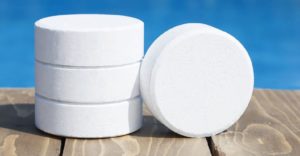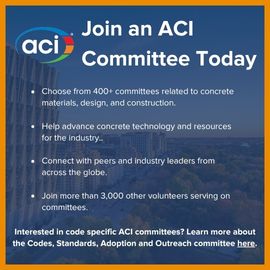
Trichlor: The dependable pool performer
 A true staple of residential pool care, trichlor has gained prominence due to its straightforward application of the pool industry’s ubiquitous sanitizer, chlorine. Trichlor contains the highest available chlorine content (90 percent) of any chlorine sanitizing pool treatment chemical except gaseous chlorine (100 percent).
A true staple of residential pool care, trichlor has gained prominence due to its straightforward application of the pool industry’s ubiquitous sanitizer, chlorine. Trichlor contains the highest available chlorine content (90 percent) of any chlorine sanitizing pool treatment chemical except gaseous chlorine (100 percent).
Trichlor, or more specifically trichloro-s-triazinetrione, is an EPA-registered pesticide sold for use as a sanitizer for pools and spas. It is soluble in water, forming hypochlorous acid and hypochlorite ion or free available chlorine (FAC). Hypochlorous acid is more effective as a biocide than hypochlorite ion. The relative amounts of hypochlorous acid and hypochlorite will depend on pH. Therefore, always maintain the pH between the recommended values of 7.2 and 7.8. The biocidal properties of trichlor are due principally to hypochlorous acid, which kills bacteria, algae and other microorganisms. Because a residual level of FAC can be maintained with the use of trichlor, it is classified as a primary sanitizer.
Trichlor is sold in tablet, stick and granular forms, which are simple and convenient ways to chlorinate pools and spas continuously. These forms are completely soluble in water and do not generate insoluble solids. Also, trichlor does not contribute to scaling — thus, trichlor products are suitable for hard water.
Trichlor is typically sold by the manufacturer as a granular product with 99 percent purity. Trichlor tablets, the most common form, are usually made from the unadulterated granular product and will contain at least 0.90 pounds of available chlorine per pound of product. This is equivalent to 0.9 pounds of gaseous chlorine and is the reason that the label indicates that the product contains 90 percent available chlorine. Trichlor products are available with additives that may provide additional benefits to the user. However, it is important to note that if additives are mixed with the product, the available chlorine will be less than 90 percent. The available chlorine content is provided on product labels.
In addition to its use as a primary sanitizer, trichlor can perform additional water treatment functions to control algae and to oxidize contaminants and chloramines. If the proper concentration of free chlorine (1 – 4 ppm) is maintained in the pool with trichlor, the swimming pool water will be properly sanitized, that is, the bacteria will be killed fast enough to control their populations in the pool water. The free chlorine concentration for spas should be 2 – 5 ppm. The free chlorine generated from trichlor helps provide clear water by killing algae and by destroying organic matter that will cloud the water if allowed to accumulate. Chloramines, the most common cause of unpleasant odors, can be reduced by the action of free chlorine.
When trichlor is used, 0.6 ppm of cyanuric acid is added to the water for each ppm of available chlorine added. A certain amount of cyanuric acid (usually within the range of 30 – 50 ppm) is necessary to protect outdoor pools from degradation by sunlight. When the recommended level of cyanuric acid is maintained, it slows down the degradation of free chlorine by sunlight and enables the free chlorine to last 3 – 4 times longer than free chlorine in outdoor pools without cyanuric acid. The effect of cyanuric acid on slowing the oxidation of organics, kill rates of bacteria, viruses and algae has been demonstrated, primarily in controlled laboratory studies.
Cyanuric acid is a very stable molecule and does not readily degrade in swimming pools and spas. If the cyanuric acid level exceeds the APSP maximum of 100 ppm, a partial drain and refi ll is recommended. Draining
Trichlor basics
- Highest available chlorine content of solid chlorine sanitizers
- Use provides cyanuric acid, which stabilizes free chlorine
- A concentrated source of chlorine in solid form
- Provides a residual level of free available chlorine in pool and spa water to kill disease-causing organisms
- Acts as a sanitizer, algaecide and/or shock (granular) product depending on application method
- Destroys contaminants in pool and spa water such as those found in sweat, urine and wind-blown debris
- Proper application gives excellent water clarity
- Available in slow-dissolving tablet, stick or granular form
- Completely soluble in water
- pH and alkalinity of treated water may drift down
- Does not contain calcium
- Suitable for use in pools and spas with hard water has the advantage of removing contaminants that have built up through pool and/or spa use and is suggested as a periodic practice for all pools and spas to control the total dissolved solids.
Application
The ways trichlor products are used depend on the purpose of application and the product form. The EPA-registered product label will have explicit use instructions that describe how to apply the material for specific application purposes. Application methods will depend on the product form (tablets, sticks or granules) and can range from broadcasting and skimmer feeding to the use of tablet feeders or floater feeders.
The amount of product to be used or dispensed depends on the specific application and the water volume. For example, in routine sanitizing use, the objective is to maintain a residual available chlorine (FAC) concentration of 1 – 4 ppm for pools and 2 – 5 ppm for spas. The use instructions will explain how to determine a typical dosage for the water volume at hand. The label use instructions will similarly define dosage requirements for other product applications such as oxidation, shock treatment or super-chlorination.
The requirements for pool water testing in the application of trichlor-based products should be indicated on the product label. The primary parameter to be tested is the level of FAC in the water. The choice of testing methods will vary depending on the type of pool (residential or commercial) and local regulations and standards. The product label should recommend that the pool water quality be properly balanced. This requires testing the pool water balance parameters for pH, alkalinity, calcium hardness and stabilizer (i.e., cyanuric acid).
In white plaster pools, granular trichlor is often used to treat black algae that commonly grows in the cracks and crevices of the pool surfaces. Granular trichlor should not be used in vinyl-lined pools for this purpose because it dissolves very slowly. As a result, it is possible to bleach the vinyl liner.
Precautions
In order to safely use and handle trichlor products, all individuals involved in their manufacture, distribution, sale and use should be trained and knowledgeable about their properties. Safety information is available on the product label, product material safety data sheet and manufacturer’s training materials. This safety information will include product and packaging disposal instructions and spill response information.
Trichlor is a dry solid with strong oxidizing properties. It is stable when stored in a cool, dry, ventilated area and not contaminated by other chemicals such as acids or easily oxidizable materials. Trichlor in the solid form should not be mixed with other pool chemicals, including other chlorinating agents. Partially empty packages must not be consolidated, as this could result in dangerous mixing with incompatible dry chlorinating agents that have a similar appearance.
Special cautionary note: If mishandled, improperly stored or contaminated, trichlor products can become unstable and dangerous, as is the case with chlorinating agents in general. Fire, explosion and/or evolution of toxic gasses could result, depending on the nature and amount of the contaminant.
As with any oxidizer, trichlor can oxidize metals and may result in staining of pool and spa surfaces.
This article originally appeared in the May 2019 issue of AQUA Magazine and is reprinted with permission.







